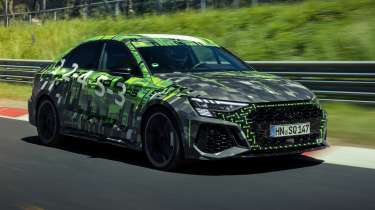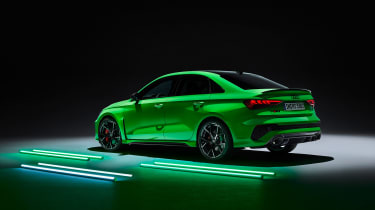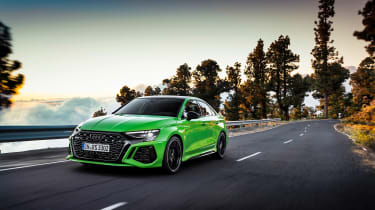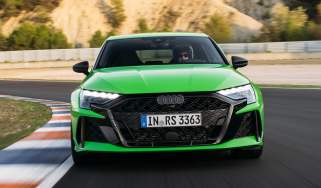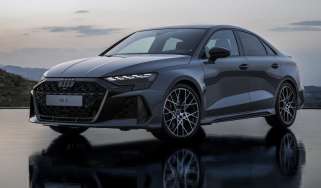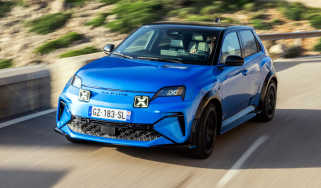New Audi RS3 laps Nürburgring in 7:40.74
The all-new Audi RS3 has hit the Nürburgring, achieving the fastest time in the compact class
Not long after its reveal, Audi’s next generation RS3 has proven its worth on the Nürburgring with a record-breaking lap. First examples are expected to hit UK roads by the end of 2021, with the entry-level car costing from £50,900, a few hundred pounds below its arch rival, the Mercedes-AMG A45 S.
Audi revealed in June that development driver Frank Stippler achieved a 7:40.748 Nürburgring lap time, making the new RS3 the fastest compact car around the 12.94-mile circuit – this time puts it 4.64sec ahead of Renault’s hardcore Megane RS Trophy-R. To complete the lap, Audi altered only the tyre pressures of the RS3’s optional Trofeo R tyres, leaving everything else completely standard.
> Mercedes-AMG A45 S review - a new high water mark?
Th RS3 will once again be available in five-door hatchback and saloon forms, the new model follows a similar recipe to its predecessor, but comes with one or two critical differences under the aggressive new skin.
These changes are in the form of some clever new hardware and an aggressive new set-up – two elements that have been designed specifically to help rid the RS3 of its reputation of somewhat blunt, nose-heavy handling. This starts with the application of a torque-vectoring rear differential in a similar style to that of the Mercedes-AMG A45 S, which is able to mechanically split power between the two rear wheels in different fashions depending on the selected driver mode. In Dynamic mode, the rear axle will apportion a subtle majority of torque to the outside rear wheel in corners, focusing on traction and grip. But when Audi’s new RS Torque Rear mode is selected, it’ll send 100 per cent of the available torque to the outside wheel, in essence giving it a very oversteer-led balance.
Of course, being a front-led all-wheel-drive system, the rear axle will only ever receive a maximum of 50 percent of the total engine power, so like many hot hatchbacks with this technology it’ll still fundamentally feel all-wheel drive. Given the beneficial effect this tech has had in other hot hatchbacks though, it should go some way to helping banish the RS3’s reputation of having a stodgy, nose-led handling bias.
Joining the new rear differential is a substantially uprated front end, with a wider track, bespoke pivot bearings and stiffer lower wishbones, subframes and stabilisers. There’s also an extra degree of negative camber compared to standard A3 models, and it sits 25mm lower too. German-market cars will sit on passive dampers, with adaptive ones an option, but based on previous RS3 specifications we suspect that UK cars will come with the latter as standard. What no RS3 will include is a Golf R-style fully variable damper function, Audi instead sticking with more traditional presets.
Powering the new RS3 is the familiar, yet still brilliant DQ500 2.5-litre turbocharged in-line five, which at 394bhp doesn’t produce any more power than before, but reaches it over a broader rev range between 5600 and 7000rpm. It has had a subtle uplift in torque to 369lb ft (+15lb ft) between 2250 and 5600rpm. Both of these help get the RS3 to 62mph in 3.8sec, a 0.3sec drop compared to before and crucially 0.1sec in front of the A45 S. The seven-speed dual-clutch transmission is also carried over and, finally, there’s also a new and totally variable sports exhaust system.
Top speed is limited to 155mph, but can be raised to 174mph optionally with the standard cast iron brakes or 180mph when fitted with the optional ceramic discs as part of the optional RS Dynamic package. Audi will also offer the RS3 with optional Pirelli Trofeo R tyres in overseas markets, but has confirmed they will not be available on UK cars from the factory.
Perhaps the biggest change for the new RS3, though, is its aesthetic which has morphed from subtle and understated in its prior generations (when specified accordingly) to something rather more brash. The nose features the same black mask design as seen on both Audi’s RS3 LMS racing car and the e-tron GT, blending its grille and headlights into a single darkened graphic.
As with all RS3’s, the wider front track has required bespoke front wings, and in this case Audi’s designers have again referenced the e-tron GT by leaving a large slip vent at the leading edge of the front door, which combined with the standard A3’s bulky arches makes the RS3 very broad and muscular. At the rear, typical RS oval pipe finishers remain but now sit under a full-width vent graphic on the rear bumper which is entirely fake. The overall effect is an aggressive one, and even when specified in a dark colour to lessen the contrast of its nose, it won't likely be able to go unnoticed like its predecessors.
The new RS3 will reach the UK by the end of the year starting at £50,900, putting it a few hundred pounds below its Mercedes-AMG A45 S arch rival which costs from £51,245. Full UK specifications are still being finalised, but Audi UK has confirmed that the RS Dynamic Pack, which includes ceramic brakes, will be available alongside the four confirmed UK trim levels made up by base RS3, Carbon, Launch Edition and top-spec Vorsprung.
